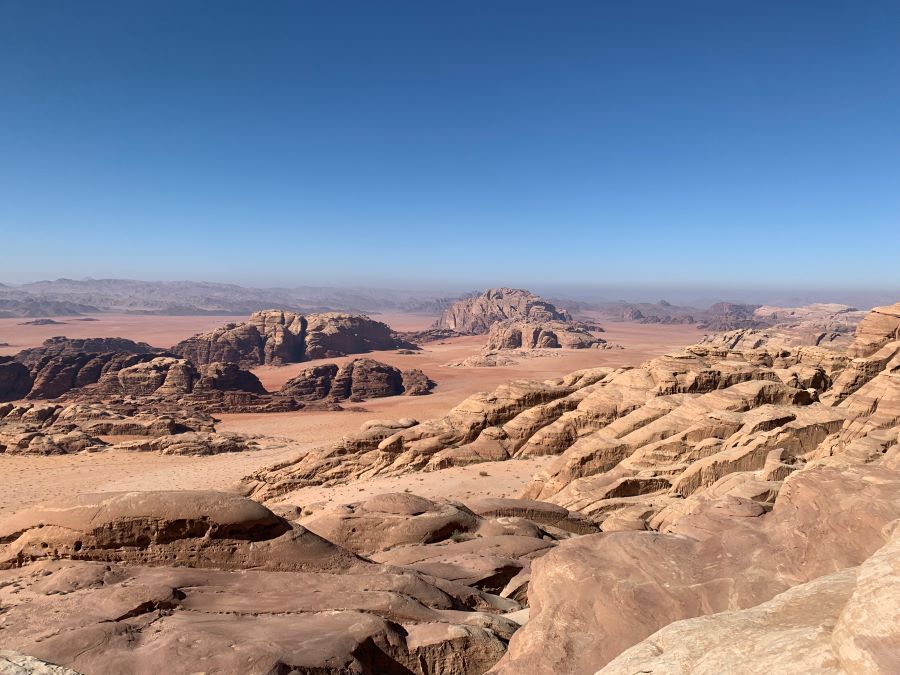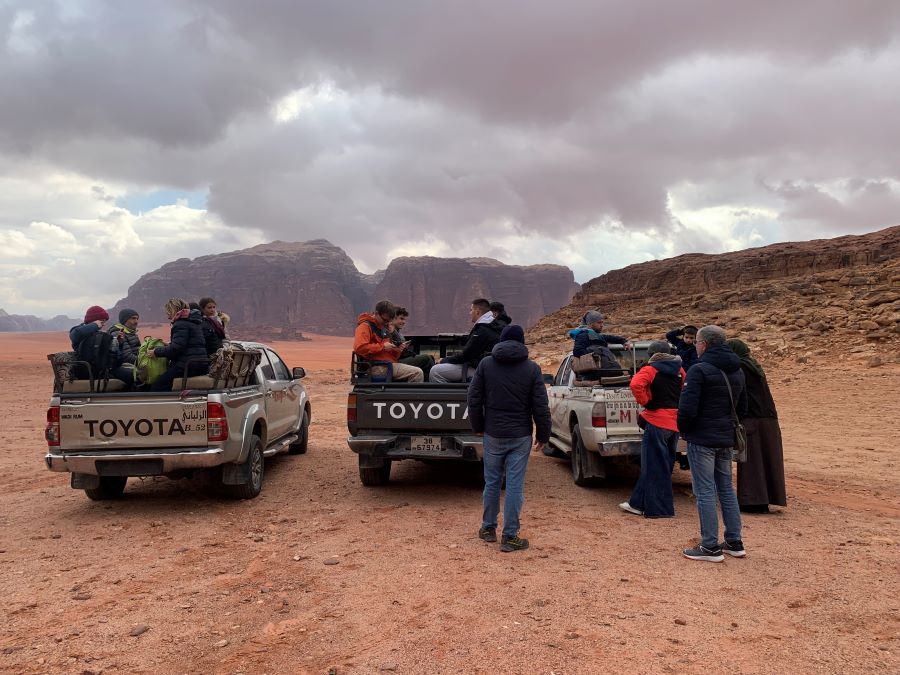Our Actions

Rocks, Romans, and Lawrence of Arabia: A Brief History of Wadi Rum
Part 1: Early history of Wadi Rum
Geological Formation of the Area
First off, let's talk about the rocks. Have you seen the rocks here? They're incredible! The sandstone and granite formations that make up Wadi Rum were created over millions of years, through erosion and weathering. And the colours...oh man, the colours! Depending on the time of day, the rocks can turn all sorts of shades, from deep reds to bright pinks and yellows. If you're lucky enough to go on one of our hiking tours, you'll get to witness all this for yourself!
Nomadic Presence in the Region
Now, let's get into the human history of the place. Wadi Rum has been inhabited by nomads for thousands of years. The Bedouins, in particular, have a long history in the region. These are a group of Arabic-speaking people who traditionally lived in tents and relied on camel herding, trading, and other activities to survive. They were constantly on the move, searching for water and food in the harsh desert landscape.
Nomadic Presence in the Region
But the Bedouins weren't the only ones to pass through Wadi Rum. Ancient civilizations like the Nabateans and the Romans also made their mark on the area. The Nabateans were a powerful Arab tribe that rose to prominence in the 2nd century BC.
They were skilled at carving outbuildings and other structures from rock, and you can still see their influence in the many rock-cut tombs and temples in Wadi Rum. And the Romans, who conquered much of the Middle East in the 1st century BC, used Wadi Rum as an important stop on their trade routes that connected the Mediterranean to the Red Sea.
So there you have it, folks - a quick summary of the early history of Wadi Rum. It's amazing to think about all the different groups of people who have passed through here over the centuries. And the best part is, you can still come and visit this incredible place today!
Part 2: Bedouin History and Culture
Let's dive into the fascinating world of the Bedouin, the nomadic people who have been roaming the desert landscapes of Jordan for centuries. These guys have a rich culture and way of life that is deeply rooted in the history of Wadi Rum, and has had a huge impact on the region's modern tourism industry.
Bedouin tribes that have traditionally inhabited Wadi Rum
The Bedouin tribes that traditionally inhabit Wadi Rum include the Zalabia, Abulayhah, and Zalaga. Each tribe has its own unique language, customs, and traditions. They're known for living in tents made from goat hair and for relying on camel herding, trade, and other activities to survive in the harsh desert environment.
Bedouin culture, traditions, and way of life
The Bedouin way of life is all about hospitality, honor, and mutual support. If you're lucky enough to visit Wadi Rum, you'll likely be invited into a Bedouin tent for tea or coffee and a chance to learn more about their culture. You might see women weaving traditional rugs, men tending to their camels, or kids playing games.
Bedouin traditions and customs are heavily influenced by Islam, which is the dominant religion among Bedouin in Jordan. They follow strict rules around hospitality, generosity, and respect for elders. Bedouin music, dance, and poetry are also an important part of their cultural heritage, and are often performed during festivals and celebrations.
Influence of Bedouin culture on the modern tourism industry in Wadi Rum
The Bedouin way of life has had a huge impact on the modern tourism industry in Wadi Rum. Many Bedouin families now run campsites and offer guided tours of the desert, sharing their knowledge of the landscape, culture, and history of the region with visitors. These tours often include opportunities to learn about traditional Bedouin crafts, like weaving and cooking, and to experience Bedouin hospitality firsthand.
But, as with any cultural shift, there are challenges. As more and more tourists visit Wadi Rum, there's increasing pressure for Bedouin families to adapt to Western standards of hospitality and provide modern amenities, like hot showers and air conditioning. Finding the balance between preserving their cultural heritage and catering to visitors can be tough.
Part 3: Lawrence of Arabia and World War I
Hold on to your hats, folks, because we're about to dive into some epic history! In this chapter, we'll be talking about the legendary figure of T.E. Lawrence and his involvement in the Arab Revolt, as well as the significant events and battles that took place in Wadi Rum during World War I.
T.E. Lawrence's involvement in the Arab Revolt and his time in Wadi Rum
T.E. Lawrence, better known as Lawrence of Arabia, was a British archaeologist, military officer, and diplomat who played a crucial role in the Arab Revolt against the Ottoman Empire during World War I. He arrived in Wadi Rum in 1917 as part of his efforts to support the Arab Revolt, and spent a significant amount of time in the area.
Lawrence was fascinated by the landscape of Wadi Rum and used it as a base for his operations against the Ottomans. He was instrumental in organizing and leading guerrilla raids on Ottoman outposts and supply lines in the area, which significantly weakened their hold on the region. Lawrence also formed close relationships with the local Bedouin tribes, who provided valuable support to the Arab Revolt.
Significant events and battles that took place in Wadi Rum during World War I
Some of the most significant events and battles of World War I took place in Wadi Rum. In 1917, British forces under the command of General Allenby launched a major offensive against the Ottoman Empire, which had been occupying Palestine and Jordan. The battle for the capture of Aqaba, a key port on the Red Sea, was fought in the desert around Wadi Rum. This was a pivotal moment in the war, as it helped pave the way for the eventual defeat of the Ottoman Empire.
Wadi Rum was also the site of several other significant battles and skirmishes during World War I, including the battles of Abu al-Lissal and Amman, both of which saw heavy fighting between British and Ottoman forces. The legacy of these battles can still be seen in the landscape of Wadi Rum today, with the remains of trenches, fortifications, and other military structures dotting the desert landscape.
Overall, the involvement of T.E. Lawrence and the significant events and battles that took place in Wadi Rum during World War I are a testament to the strategic importance of the region and its role in shaping the history of the Middle East.
Part 4: Wadi Rum in the 20th Century
Hold on to your camel saddles, folks, because we're about to fast-forward to the 20th century and talk about the modern tourism industry in Wadi Rum, the protection of the area's natural and cultural resources, and the role of this spectacular region in Jordan's economy and cultural heritage.
Development of the modern tourism industry in Wadi Rum

In the mid-20th century, the Jordanian government recognized the potential of Wadi Rum as a tourist destination and began investing in infrastructure and services to attract visitors. Today, Wadi Rum is a popular destination for adventurers, nature lovers, and history buffs from all over the world. From jeep tours to camel treks, there's no shortage of activities to do and sights to see in this stunning desert landscape.
Protection of the area's natural and cultural resources
But with the growth of tourism comes the responsibility to protect the natural and cultural resources that make Wadi Rum such a unique and special place. The Jordanian government has implemented several initiatives to preserve the area's delicate ecosystem and rich cultural heritage. For example, the Bedouin communities who have traditionally inhabited the region are involved in the management and operation of tourism activities, helping to ensure that visitors have an authentic and sustainable experience.
The role of Wadi Rum in Jordan's economy and cultural heritage
Wadi Rum's importance goes beyond just tourism, however. The region plays a significant role in Jordan's economy and cultural heritage. It is home to several Bedouin communities who continue to maintain their traditional way of life, and the ancient rock art and inscriptions found throughout the area provide valuable insights into the history of the region and its inhabitants. In addition, Wadi Rum has served as a backdrop for several movies and TV shows, including the iconic film "Lawrence of Arabia," which have helped to raise its profile on the global stage.
Wadi Rum's modern history is a story of growth, conservation, and cultural significance. As we continue to explore and appreciate this amazing region, it's important to remember the responsibility we have to protect its natural and cultural treasures for generations to come.
This is why Wadi Rum Eco Tours is committed to sustainability and reducing the impact that tourism has on the region’s environment. While you may be tempted to book extravagant, luxury accommodation and enjoy air conditioning and private bathrooms, keep in mind that these luxuries were not a part of the Bedouin’s traditional way of life (and are still not in most cases), so the authenticity of your experience is affected.
In addition, the environmental impact you will have is by far more substantial. By choosing smaller camps with shared bathroom facilities, more traditional tents with fewer luxury amenities and a company that cares about the environment, you can travel with reduced environmental impact.




